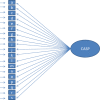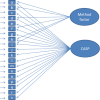The Multidimensional Structure of Subjective Well-Being In Later Life
- PMID: 25089162
- PMCID: PMC4102758
- DOI: 10.1007/s12062-014-9092-9
The Multidimensional Structure of Subjective Well-Being In Later Life
Abstract
Subjective well-being can be measured in different ways, depending on the conceptual perspective one adopts. Hedonic well-being, emphasising emotions and evaluation, is often contrasted with eudemonic well-being, stressing self-actualisation and autonomy. In this paper we investigate the background, structure and compatibility of empirical measures of hedonic and eudemonic well-being in the English Longitudinal Study of Ageing (ELSA). We use a confirmatory factor approach to investigate the internal of structure of the General Health Questionnaire (GHQ), Centre for Epidemiological Studies Depression scale (CES-D), Satisfaction with Life scale (SWLS) and CASP, a measure of quality of life in old age. In a second step, we examine the higher order structure of well-being using these measures. Next to highlighting specific issues about the structure of these measures in connection to older populations, we illustrate that a threefold structure, distinguishing affective, cognitive and eudemonic aspects of well-being, is more informative than the two dimensional hedonic and eudemonic well-being that is often propagated.
Keywords: Confirmatory factor analysis; Measurement; Subjective well-being.
Figures






References
-
- Ariely G, Davidov E. Assessment of measurement equivalence with cross-national and longitudinal surveys in political science. European Political Science. 2011;1:1–15.
-
- Beaumont, J. (2011). Measuring National Well-being - Discussion paper on domains and measures. London.
-
- Bollen, K. A. (1989). Structural equations with latent variables (p. 514). Wiley.
Grants and funding
LinkOut - more resources
Full Text Sources
Other Literature Sources
